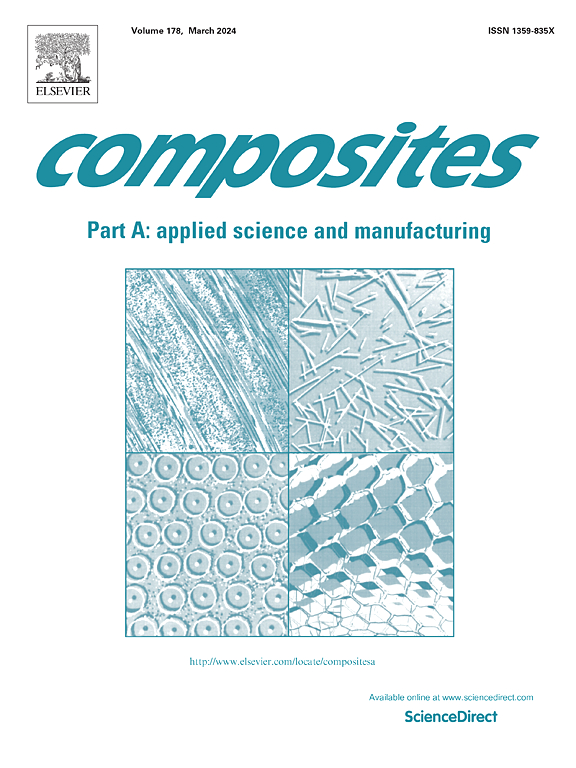通过聚醚砜成分优化和量产适用性评估开发高韧性航空航天复合材料
IF 8.1
2区 材料科学
Q1 ENGINEERING, MANUFACTURING
Composites Part A: Applied Science and Manufacturing
Pub Date : 2024-11-14
DOI:10.1016/j.compositesa.2024.108590
引用次数: 0
摘要
由于有必要为能够在极端环境中工作的军用无人机(UAV)开发机身材料,因此使用高韧性环氧树脂体系开发了航空航天级复合材料,并随后对其进行了分析和评估。为优化树脂系统,对高韧性环氧树脂系统的相变行为进行了建模和模拟,并将其作为增韧剂聚醚砜(PES)及其含量的函数。通过实验验证确保了可靠性。当 PES 含量达到与环氧树脂基体和固化剂含量相适应的最大值时,环氧树脂体系表现出最高的拉伸强度和韧性。然而,使用试验工艺进行的初步测试结果表明,由于添加了聚醚砜,粘度增加到一定程度后就不适合应用于大规模生产工艺。根据使用试验工艺生产树脂纸的结果,确定了适合大规模生产的高韧性环氧树脂系统的最佳成分。然后批量生产了高韧性碳纤维增强塑料(CFRP),并将其特性与传统增韧 CFRP 和试验产品进行了比较。结果证实,与传统增韧碳纤维增强塑料相比,含有高韧性树脂体系的量产碳纤维增强塑料在压缩-冲击后强度、模式-I层间断裂韧性(ILFT)、模式-II裂纹萌发ILFT和模式-II裂纹扩展ILFT方面分别提高了246%、728%、392%和480%。此外,这些复合材料还被用于制造无人机机翼,以评估其在机身结构中的适用性。本文章由计算机程序翻译,如有差异,请以英文原文为准。

Development of high-toughness aerospace composites through polyethersulfone composition optimization and mass production applicability evaluation
Owing to the necessity of developing airframe materials for military unmanned aerial vehicles (UAVs), capable of operating in extreme environments, aerospace-grade composite materials were developed using a high-toughness epoxy–resin system, and were subsequently analyzed and evaluated. The phase transition behavior of a high-toughness epoxy–resin system was modeled and simulated as a function of the toughening agent, polyethersulfone (PES), and its content to optimize the resin system. Reliability was ensured through experimental validation. At the maximum PES content compatible with the base epoxy–resin and curing agent contents, the epoxy–resin system exhibited the highest tensile strength and toughness. However, results from preliminary tests performed using the pilot process revealed that an increase in viscosity beyond a certain level due to the addition of PES rendered it unsuitable for application in mass-production processes. The optimal composition of the high-toughness epoxy–resin system suitable for mass production was determined based on the results of the resin paper production using the pilot process. High-toughness carbon fiber-reinforced plastics (CFRPs) were then mass produced, and their characteristics were compared with those of conventionally toughened CFRPs and the pilot products. The results confirmed that compared with the conventionally toughened CFRPs, the mass-produced CFRPs containing the high-toughness resin system showed 246%, 728%, 392% and 480% improvement in compression-after-impact strength, Mode-I interlaminar fracture toughness (ILFT), Mode-II ILFT for crack initiation, and Mode-II ILFT for crack propagation, respectively. In addition, these composites were used to manufacture UAV wings to evaluate their applicability in airframe structures.
求助全文
通过发布文献求助,成功后即可免费获取论文全文。
去求助
来源期刊

Composites Part A: Applied Science and Manufacturing
工程技术-材料科学:复合
CiteScore
15.20
自引率
5.70%
发文量
492
审稿时长
30 days
期刊介绍:
Composites Part A: Applied Science and Manufacturing is a comprehensive journal that publishes original research papers, review articles, case studies, short communications, and letters covering various aspects of composite materials science and technology. This includes fibrous and particulate reinforcements in polymeric, metallic, and ceramic matrices, as well as 'natural' composites like wood and biological materials. The journal addresses topics such as properties, design, and manufacture of reinforcing fibers and particles, novel architectures and concepts, multifunctional composites, advancements in fabrication and processing, manufacturing science, process modeling, experimental mechanics, microstructural characterization, interfaces, prediction and measurement of mechanical, physical, and chemical behavior, and performance in service. Additionally, articles on economic and commercial aspects, design, and case studies are welcomed. All submissions undergo rigorous peer review to ensure they contribute significantly and innovatively, maintaining high standards for content and presentation. The editorial team aims to expedite the review process for prompt publication.
 求助内容:
求助内容: 应助结果提醒方式:
应助结果提醒方式:


